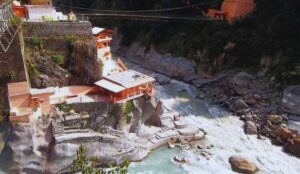“🌊 Dive into the majesty of Alaknanda River! Explore its journey through the Himalayas in our immersive blog. 🏞️ #AlaknandaRiverMagic”
Origin and Course:
- Alaknanda River is a major tributary of the Ganges, originating from the Satopanth Glacier in Uttarakhand, India.
- It flows through the Garhwal Himalayas, merging with the Bhagirathi River at Devprayag to form the Ganges.
Scenic Beauty:
- The river traverses picturesque landscapes, including lush valleys, alpine meadows, and charming villages.
- Its pristine waters and breathtaking surroundings attract nature enthusiasts and adventure seekers.
Importance and Significance:
- Alaknanda holds spiritual importance, with numerous temples and sacred sites along its banks.
- It provides water for irrigation, hydropower generation, and sustains local communities.
History of Alaknanda River:
Cultural and religious importance:
- The river’s banks are dotted with revered pilgrimage sites like Badrinath and Joshimath.
- It is deeply intertwined with Hindu mythology and has a place in ancient scriptures.
Colonial Exploration:
- British explorers studied the river’s course and contributed to geographical knowledge.
- The river’s historical exploration added to our understanding of the Himalayan region.
Environmental Changes:
- Like many Himalayan rivers, the Alaknanda faces challenges due to climate change and developmental activities.
- Awareness and conservation efforts aim to preserve its ecological balance and cultural heritage.
Alaknanda River: Location and Insights
River’s Geographic Origin:
- The Alaknanda River originates from the Satopanth Glacier, situated in the Indian state of Uttarakhand.
- The glacier lies within the stunning Garhwal Himalayas, a region known for its natural beauty.
Course and Confluence:
- The river flows through the picturesque landscapes of Uttarakhand, meandering through valleys and mountains.
- At the confluence point in Devprayag, the Alaknanda merges with the Bhagirathi River to form the mighty Ganges.
Natural Beauty and Scenic Appeal:
- The Alaknanda River’s journey takes it through charming villages, alpine meadows, and serene surroundings.
- Its crystal-clear waters and breathtaking vistas make it a popular destination for nature lovers and adventurers.
Challenges and Conservation
- The Alaknanda faces environmental challenges due to climate change and developmental activities.
- Conservation efforts strive to protect its delicate ecosystem and preserve its cultural heritage.
Alaknanda River: Reasons for its Prominence
Natural Splendor:
- The Alaknanda River’s scenic beauty lies in its pristine waters and the stunning landscapes it traverses.
- Its course through the Garhwal Himalayas adds to its allure, making it a popular destination.
Spiritual Significance:
- The river holds immense religious importance, hosting revered pilgrimage sites along its banks.
- People visit to seek blessings and immerse themselves in the spiritual ambiance.
Cultural Heritage:
- Alaknanda’s association with Hindu mythology and ancient scriptures enhances its cultural significance.
- It remains deeply interwoven with local customs and traditions.
Things to Do Along Alaknanda River
Pilgrimage Journeys
- Embark on a pilgrimage to the holy shrines of Badrinath, Joshimath, and other sacred sites.
- Experience the spiritual aura and connect with centuries of cultural heritage.
Adventure and Water Activities
- Adventure enthusiasts can indulge in white-water rafting and kayaking along the river’s rapids.
- The challenging waters offer an adrenaline-pumping experience amidst breathtaking scenery.
Nature Exploration
- Explore the picturesque landscapes by hiking or trekking along the river’s banks.
- Capture the beauty of alpine meadows, cascading waterfalls, and serene surroundings.
Photography and Relaxation
- Photographers can capture the mesmerizing play of light on the river’s surface and the surrounding landscapes.
- Find solace by simply sitting by the riverbank, absorbing its tranquility and natural splendor.
Cultural Immersion
- Interact with local communities to understand their way of life and traditions.
- Attend local festivals or fairs to experience the rich cultural tapestry of the region.
Things to Know about Alaknanda River
Origin and Course
- Alaknanda River originates from the Satopanth Glacier in Uttarakhand’s Garhwal Himalayas.
- It flows through scenic landscapes, merging with the Bhagirathi River to form the Ganges.
Cultural Significance
- Alaknanda’s banks host revered pilgrimage sites like Badrinath and Hemkund Sahib.
- The river is considered sacred, attracting devotees seeking spiritual experiences.
Natural Beauty
- The river’s crystal-clear waters and the surrounding Himalayan scenery create a captivating panorama.
- Its course through valleys, forests, and villages enhances its natural charm.
How to Reach Alaknanda River
Access Points
- Reach Rishikesh or Haridwar, two well-connected cities in Uttarakhand.
- From here, undertake a road journey to the different towns and villages along the Alaknanda’s course.
Pilgrimage Route
- Devprayag, where the Alaknanda meets the Bhagirathi, is a major starting point for spiritual journeys.
- Pilgrims then proceed to Badrinath, completing a sacred circuit.
Adventure Routes
- For adventure enthusiasts, reach Joshimath, a gateway to treks and activities in the region.
- Embark on treks or engage in water sports to experience the river’s dynamic facets.
Travel Considerations
- The region’s weather can be unpredictable, so pack accordingly.
- Ensure permits, local regulations, and safety measures are adhered to during your visit.
Travel Tips for Exploring Alaknanda River
Preparation and Research
- Study the region’s geography, culture, and local customs before your journey.
- Plan your itinerary, considering nearby attractions and accommodations.
Essential Gear
- Pack sturdy footwear, comfortable clothing, rain gear, and insect repellent.
- Carry a first aid kit, personal medications, and any necessary outdoor equipment.
Respect Nature and Culture
- Follow eco-friendly practices to minimize your impact on the environment.
- Respect local traditions, be mindful of religious sites, and interact respectfully with locals.
Safety Measures
- Prioritize safety by wearing appropriate gear and adhering to guides’ instructions.
- Be cautious near water bodies and steep terrain to prevent accidents.
Stay Hydrated and Nourished
- Carry a sufficient supply of water and energy-rich snacks during your explorations.
- Try local cuisine for a unique culinary experience while maintaining proper hydration.
Best Time to Visit Alaknanda River
Summer (May – June)
- Pleasant temperatures make it an ideal time for outdoor activities and exploration.
- Enjoy the natural beauty without extreme weather conditions.
Post-Monsoon (September – October)
- The region comes alive after the rains, with lush landscapes and clear skies.
- Moderate temperatures and clear views offer great trekking and sightseeing opportunities.
Dining Options Around the Alaknanda River
Local Culinary Experiences
- Embrace the flavors of Uttarakhand by trying local dishes at nearby eateries.
- Indulge in traditional cuisine to immerse yourself in the region’s food culture.
Village Eateries and Cafes
- Villages along the riverbanks might offer simple yet delicious meals.
- Enjoy a taste of authentic, home-cooked meals that reflect the local lifestyle.
Self-Catering and Picnics
- Carry non-perishable snacks, energy bars, and ready-to-eat meals for convenience.
- Opt for picnics by the river, enjoying the scenery while relishing your packed food.
Nearby Attractions and Activities
Spiritual Pilgrimage Sites
- Visit revered temples like Badrinath and Hemkund Sahib, located near the river.
- Immerse yourself in the spiritual ambiance of these sacred destinations.
Adventure and Recreation Spots
- Explore Joshimath, a town offering adventure activities and trekking opportunities.
- Engage in outdoor pursuits while experiencing the dynamic facets of the region.
Natural Exploration and Photography
- Trek along the riverbanks to soak in the natural beauty of the surroundings.
- Capture the mesmerizing landscapes and diverse flora and fauna through your lens.
Joshimath: A Serene Retreat Along the Alaknanda River
Nestled in the picturesque Garhwal Himalayas of Uttarakhand, India, Joshimath is a charming town located along the banks of the Alaknanda River. Known for its religious significance, natural beauty, and accessibility to various trekking routes and pilgrimage sites, Joshimath has become a popular destination for both spiritual seekers and adventure enthusiasts.
Spiritual Significance
Joshimath holds a special place in Hindu mythology and pilgrimage. It is considered one of the “Sapta Badri” (Seven Badris) and serves as the winter seat of Lord Badri, an incarnation of Lord Vishnu. The town is home to the Narasimha Temple, an important shrine dedicated to Lord Vishnu. Thousands of devotees visit the temple, seeking blessings and solace in its serene surroundings.
Gateway to Spiritual Journeys
Joshimath serves as a base for pilgrims embarking on the revered Char Dham Yatra, which includes visits to Badrinath, Kedarnath, Gangotri, and Yamunotri. The town also marks the beginning of the trekking route to the sacred Valley of Flowers National Park, a UNESCO World Heritage Site known for its vibrant alpine flora.
Auli: Skiing Paradise
Auli, located a short distance from Joshimath, is a renowned skiing destination. With its stunning panoramic views of the Himalayas, it attracts adventure enthusiasts from around the world. A cable car ride from Joshimath to Auli offers breathtaking vistas of the surrounding peaks, including Nanda Devi, India’s second-highest mountain.
Natural Beauty
The Alaknanda River flows gently alongside Joshimath, enhancing its natural allure. The town is surrounded by lush forests and snow-capped peaks, creating a tranquil atmosphere that’s perfect for meditation and introspection.
Accessibility
Joshimath is well-connected by road, making it accessible from various parts of Uttarakhand. It is approximately 250 kilometers from the state capital, Dehradun. The nearest airport is Jolly Grant Airport in Dehradun.
Accommodation and Local Cuisine
The town offers a range of accommodation options, from budget lodges to comfortable hotels. Visitors can savor local Garhwali cuisine and traditional North Indian dishes at the local eateries and restaurants.
Best Time to Visit
The best time to visit Joshimath is during the summer months (April to June) and the post-monsoon season (September to November). The weather is pleasant and suitable for outdoor activities, trekking, and sightseeing.
In summary, Joshimath is a serene and spiritually significant town along the banks of the Alaknanda River. With its religious sites, natural beauty, and adventure opportunities, it offers a unique blend of experiences for travelers seeking both spiritual and recreational exploration.
Conclusion
In the heart of Uttarakhand’s Garhwal Himalayas flows the enchanting Alaknanda River, weaving together nature’s beauty, spirituality, and adventure. Its origin at the Satopanth Glacier and its journey through valleys and villages create a tapestry of experiences. The river’s sacred significance and cultural heritage add to its allure, making it a cherished destination for pilgrims and travelers alike. Whether seeking spiritual solace, thrilling adventures, or a serene communion with nature, the Alaknanda River offers a captivating journey.
FAQs about Alaknanda River
1. What is the origin of the Alaknanda River?
The Alaknanda River originates from the Satopanth Glacier in the Garhwal Himalayas of Uttarakhand.
2. What are some significant pilgrimage sites along the Alaknanda River?
The riverbanks host revered temples like Badrinath and Hemkund Sahib, attracting spiritual seekers.
3. Can I engage in adventure activities near the Alaknanda River?
Yes, regions like Joshimath offer opportunities for trekking, water sports, and other outdoor pursuits.
4. What is the best time to visit the Alaknanda River?
Summer (May-June) and post-monsoon (September-October) offer pleasant weather and clear skies.
5. How do I ensure a respectful visit to the Alaknanda River region?
Prioritize eco-friendly practices, respect local customs, and adhere to safety guidelines during your visit.









